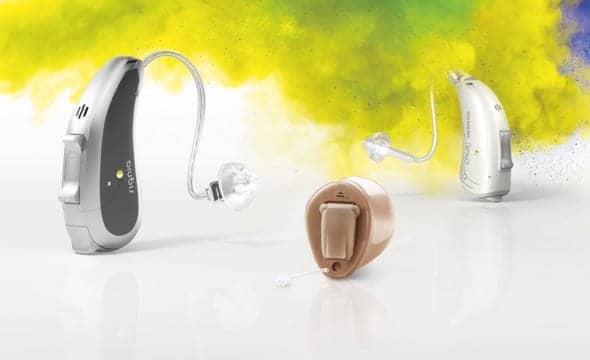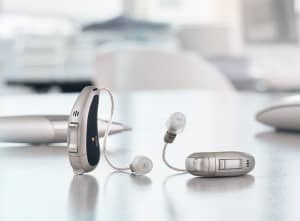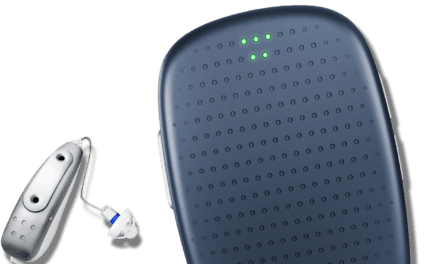Signia, the new hearing aid brand from Sivantos, has unveiled primax, described as the company’s most advanced hearing aid platform to date, and the first technology clinically proven by independent studies to reduce listening effort throughout the day while providing “better than normal” hearing in challenging listening environments like busy restaurants and cocktail settings.*
According to Signia, primax uses the binax platform to provide a binaural experience for ease of listening, and also features new technology, such as SpeechMaster, which is designed to enhance speech in every situation. The company says SpeechMaster is a collection of algorithms that work in concert to achieve less listening effort. It is designed to analyze the acoustic environment and isolate the target speaker from unwanted surrounding noise and other speech. SpeechMaster acts as a conductor orchestrating digital noise reduction, directionality, and amplification.
The new primax line also has HD Music to maximize enjoyment for music lovers and musicians by taking advantage of the high-frequency-enhancing 12 kHz extended bandwidth found in the universal program. It has three dedicated music programs that are designed to enrich the sound quality of music, whether the wearer is listening to recorded music, attending a live concert, or performing music.
EchoShield, which softens echoes for reduced listening effort, is another technology included in primax hearing aids. Available in the reverberant room program, EchoShield analyzes both direct and reflected sounds, and ensures softer reflections are not over-amplified. The effects of reverberation in atriums, hallways, lecture halls, and places of worship are said to be reduced. TwinPhone, which improves phone conversations, is another primax feature, which was designed for mobile phone users who prefer to hold their phones to their ear versus using a hands-free option. It is compatible with all phones, whether Bluetooth®-enabled or not.
For hearing aid users with single-sided deafness, primax includes CROS and BiCROS solutions that are based on e2e wireless™ 3.0, which has low energy consumption. A CROS Pure® transmitter is worn behind the unaidable ear and the audio signal is wirelessly transferred to the primax hearing aid on the other side, thus allowing the wearer to hear sounds from both sides.
“The Signia brand stands for forward-thinking innovation and customer-centered solutions, and primax delivers on all fronts,” “We know that increased listening effort can lead to listening fatigue. With Signia primax, our customers have access to technology that’s clinically proven to reduce listening fatigue, thus delivering an effortless listening experience for their patients,” said Scott Davis, chief executive officer, Sivantos Inc.
Signia primax technology is available only in hearing aids co-branded Signia and Siemens and will be offered in Pure®, Ace™, Motion™ and Insio™ custom hearing aids in 7px, 5px, and 3px performance levels. Aspire members can order now by visiting the Signia US website or or by contacting their sales representative.
*According to Signia and Sivantos, an independent clinical study in the US has shown that primax provided a significant improvement in ease of listening in demanding listening environments. A methodology using objective brain behavior measures with electroencephalographic data, showed a significant reduction in listening effort for mild to moderate hearing impaired subjects using primax hearing instruments, when applying advanced features SpeechMaster and EchoShield. Two clinical studies have shown that binax provides better than normal hearing in certain demanding environments (University of Northern Colorado, 2014; Oldenburg Horzentrum, 2013). Speech Reception Thresholds (SRT) in cocktail-party situations improved up to 2.9 dB for wearers with mild to moderate hearing loss using Carat binax or Pure binax hearing aids with narrow directionality, compared to people with normal hearing.
Source: Signia, Sivantos









My husband and I are from Battle Creek, mi. and we both have hearing aids that are six years old. We are in the process of buying new ones. I WANT a Signia Primax if it appropriate.
Is it rechargable? What about your provider? Do we do everything on line? We really appreciate the lower costs you advertize.
I am interested in Signia primax. I need more info about your provider.
I am 72 and I lost my hearing in my left ear due to a viral attack. When I lost my hearing and vestibular function 3 years ago , I was told there was nothing available to help me. Dr Shockley ifrom Yorktown Indiana , fit me with the Cros system. It is wonderful to be able to hear normally again. To set at a table with my family and be a part of the conversation!! I heard story’s about these units costing 6-10,000 dollars, which I could not afford . She was able to fit me with a basic unit for 3,000 . Thank you Signa, Carolyn
I would like to know if these have any kind of sound suppression for where ear protection is needed?
Where are some Locations in Los Angeles for an evaluation and purchase.
where are they available and how much do they cost?? need them in both ears as I am VERY hard of hearing!! PLEASE ADVISE, Thank you so much!! I shall move to Modesto CA in a few days…
Hi,
I’m curious to know if the Pure Primax or Motion Primax aids can help someone like me who suffers from severe/profound hearing loss and poor clarity? For example, I can’t understand what someone is saying when they have their back turned to me, or when they speak quickly or in a low tone. My hearing in left ear is severe at 75-95-dB HL, and my right ear is profound 95-dB/ HL. I’m hoping to find an aid that can help offer quality clarity. Thanks!
Is the battery rechargeable in the 5px? How often does it need to be changed?
Charge 1x day
How do I buy a Signia primax hearing aid? I live in Paphos Cyprus.
Looking to buy a primax 7 or 5 in Mexico. Where can I get one??
Hi there , I have SSD on my left side from sudden sensorineural hearing loss. So far I have tried Phonak ll CROS and Widex CROS, but they are not so good in noisy places like restaurants, hallways or parties. But I asked my audiologist to order the Primax for me and I am very excited to try it out. I hope it will give me better hearing when I am out with my friends in noisy places or outside. In noisy places, sounds are very muffled and I can’t hear my friends at my table. If there is music playing from the ceiling, it makes it worse. Will the Primax be a better fit for me ?
Hi Pietro I too have suffered SSHL in my right ear (2015). I have also tried Phonak and Widex BiCros hearing aids with disappointing results I have ordered the Signia BiCros Primax 7 which are claimed to be superior technology. I should be most interested to hear if you have had a better result from the Signia Primax. Please write if you have time.
Ken B
Hi,
I was wondering if you’d report back on which you ended up liking better- the Phonak or Signia? I have SSD and am looking to try Cros aid for the first time. Would love to hear about your experience if you’re wiling to share. Thanks!
Emily
Hi
I have hearing loss problem and I use CIC aids in both my ears. I decide to buy new hearing aids which have the best technology. But I am very confused and have problem to choose the best one for myself and I do not know between the CIC aids and RIC aids which one is suitable for me. Is there any way for me to send you my audiogram and get advice? Thank you so much.
Hi Pegah,
We advise that you contact Signia directly to get a timely response from them, as they may not see your message here at The Hearing Review. The contact link for Signia is here:https://www.signiausa.com/contact/
Checking on price of the Primax.